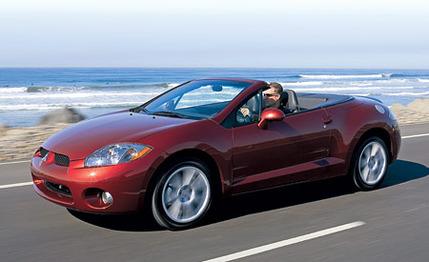
 Road Test
Road Test
Mitsubishi speaks of "the attainable exotic" in reference to the company's new Eclipse Spyder, and although that might sound like marketing hyperbole when the car in question starts at about 26 grand, you need to hear the rest of the justification.
Company spokesmen cite the car's zoomy styling and equipment, but we think it's mostly about the roof. Fabricated by the American Sunroof Company to Mitsubishi's specifications, the new ragtop is powered by a hydraulic mechanism that stows or erects it in about 19 seconds. All you do is manhandle two windshield-frame clasps and push a button.
When stowed, a power hard-tonneau panel that integrates the appearance of the rear deck covers the whole deal, tidily avoiding the so-called baby-buggy look you see with high roof stacks. The design makes no effort to mimic the coupe's roofline, and the spyder flaunts its own unique profile.
The material used is acrylic cloth, dyed black or gray before the threads are spun into fabric to avoid the uneven discoloration typically found at high-wear areas on cheaper tops. Acrylic itself is a step up from the vinyl used on some cars in the same price segment.
There's a cotton headliner, with a natural rubber layer between it and the acrylic outer fabric. Natural rubber is preferable to the more commonly used butyl rubber, says Mitsubishi, because it holds its shape better and resists stretching and shrinking during exposure to extreme temperatures. That ballooning effect you see on old convertibles is mostly due to the use of butyl rubber.
But the natural-rubber process is quite complicated. In this case, molten rubber is applied to the inner and outer roof layers using a technique known as "knife-over-roll coating" and then fused together and cured for six weeks. To ensure good sealing, Mitsubishi adopted the short-stroke mechanism we've seen on more-expensive cars with sashless windows, where the glass drops down a tad when the door is opened and closed to engage special door seals. The idea is to reduce wind noise and improve atmospheric sealing for better heater and air-conditioner performance.
The result is a pretty sturdy top, and reasonably quiet motoring, even on noisy concrete freeways in California. Mitsubishi will offer a lightweight wind deflector sometime soon that pops into place in the rear-passenger well, but we found the car relatively draft-free during our test even without it, particularly when the side windows were up. (Each window switch operates both side panes simultaneously.)
To make the driving experience as civilized as possible-top up or down-Mitsubishi retuned the exhaust system for a more subdued growl. In the process, the Spyder GT lost three horsepower and a couple of pound-feet of torque. But you won't miss them. The 3.8-liter MIVEC V-6 is so strong at low to medium revs that there isn't enough grip available anywhere-not even on a mil-spec runway rough enough to plane wood-to stop it from lighting up the front tires during a vigorous launch. Leaving on the traction control seems advisable.
As a result of the various body reinforcements (dash crossmember, floor crossmember, toughened sills and side stampings among them), our spyder carried some extra weight over that of the coupe-about 200 pounds according to Mitsubishi, but just 120 pounds according to the truck scales we weighed both models on.
One would therefore expect the spyder to run a little slower than the coupe, and it did. The dash to 60 mph took 0.6 second longer at 6.7 seconds, but that result probably had more to do with how good a launch we got, because the quarter-mile run was just 0.3 second and 1 mph slower-14.8 seconds at 99 mph.